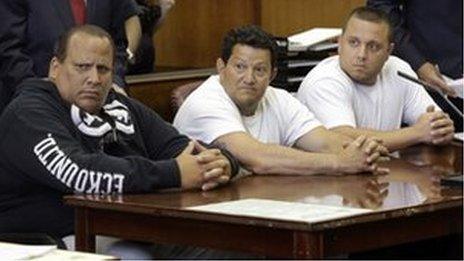New York Mafia: What's happening to the Five Families?
- Published

A 2008 file image of Frank Cali handed out by US police
It's a situation that could have been scripted by Hollywood.
Frank Cali, reputed leader of the Gambino crime family, was gunned down outside his Staten Island home in New York, just a few minutes' drive from the residence that serves as Don Corleone's compound in acclaimed film The Godfather.
Officials say the killer shot the 53-year-old six times before fleeing the scene in a pickup truck.
It marks the first targeted killing of a Mafia boss in the city since the death of the then head of the Gambino family, Paul Castellano, in 1985.
Such scenes have long been the fodder of TV dramas and big-budget blockbusters. But after a violent killing in a leafy suburb, is organised crime in New York once more on the rise?
"It's quite unheard of in New York," Oxford University professor of criminology Federico Varese tells the BBC. "It's a very significant event and shows that the Italian-American Mafia is still active."
What is the Italian-American Mafia?
Since 1931, five families have run New York's Italian-American Mafia: the Bonanno, Colombo, Gambino, Genovese and Lucchese.
Frank Cali was reputedly the head of the Gambino family. He was reportedly married to Rosaria Inzerillo, who was herself related to the Sicilian Inzerillo family. The Inzerilli fled Sicily for the US in the 1980s after losing a war with rival families.
Cali was also related to John Gambino, once leader of the family's Sicilian faction - another link that might explain his rapid rise to leadership of the mob.
The exact number of people in the family is unknown. In total, the FBI estimates there are about 3,000 members and affiliates of Italian-American organised crime groups in the US, external.
The families were once vastly powerful, wielding influence over federal and state politicians and holding stakes in entertainment industries, but the US authorities have slowly clamped down on organised crime. A series of major convictions and defections in the 1980s and 1990s crippled their leadership.
Former Gambino boss John Gotti - who planned the murder of his predecessor in 1985 outside the Sparks Steak House in Manhattan - was known as the Dapper Don for his expensive suits and flamboyant interviews with the press. Under his tenure the family, made hundreds of millions of dollars a year.

John Gotti, centre, was known as the Dapper Don
But he was convicted of five murders, tax evasion, racketeering, extortion, loansharking and illegal gambling in 1992, and received a life sentence. He died of throat cancer in a Missouri prison 10 years later.
Selwyn Raab, author of the book Five Families, told Rolling Stone magazine that the terror attacks in New York in September 2001 completely shifted the FBI's focus to terrorism, external, with some organised crime task forces dropping from about 400 agents to 20 or 30.
"When you don't have the personnel, you're not going to have the indictments or convictions," he said.
Are they still powerful?
In 2011, the FBI arrested more than 100 mob members, including the alleged street boss of the Colombo family.
Even though it was dubbed the largest round-up in the history of the FBI, the head of the bureau's New York office said that "convicting the hierarchies of the five families several times over has not eradicated the problem", external, and that the belief that that organised crime was beaten was a "myth".
Dr Anna Sergi, senior lecturer in criminology at the University of Essex, agrees.
"The Five Families are far happier than they have been in the past," she tells the BBC.
They are forging international links with Mexican and Colombian drug cartels, as well as the 'Ndrangheta from Italy's Calabria region.
Cali himself was convicted only once, after his arrest as part of Operation Old Bridge - a joint action by US and Italian law enforcement to try to quash co-operation between Italian and Italian-American crime groups.

Italian police took photos of Frank Cali in Rome as part of a joint FBI-Italian operation known as Old Bridge
Dr Sergi says Italian organised crime groups are currently changing supply routes for drugs and money, and even taking control of some operations in the US.
"This switch in power could explain this murder now," she says.
What does the killing mean?
Police do not know what the motive was. There have been no arrests, and an investigation into Cali's killing is under way.
"His murder shows that he was active and obviously he stepped on somebody's toes," Prof Varese says, calling him "a serious guy" in the organisation.
Thinking it is "very unlikely" to be a murder by an outside group or another of the families, Prof Varese suggests that on the balance of probabilities it may have been an attack by a member of his own Gambino family.
"It's not unusual that an acting boss is killed," he says. "And if that's the case the other families would not interfere."
Dr Sergi meanwhile calls the murder "very significant" and says we should not ignore the international context.
"Anything that ends up in murder has to mean a very deep scar in the system," she says.
"It's either the end of something or the beginning of something."
- Published29 November 2012

- Published28 January 2018

- Published14 January 2016

- Published10 July 2013
